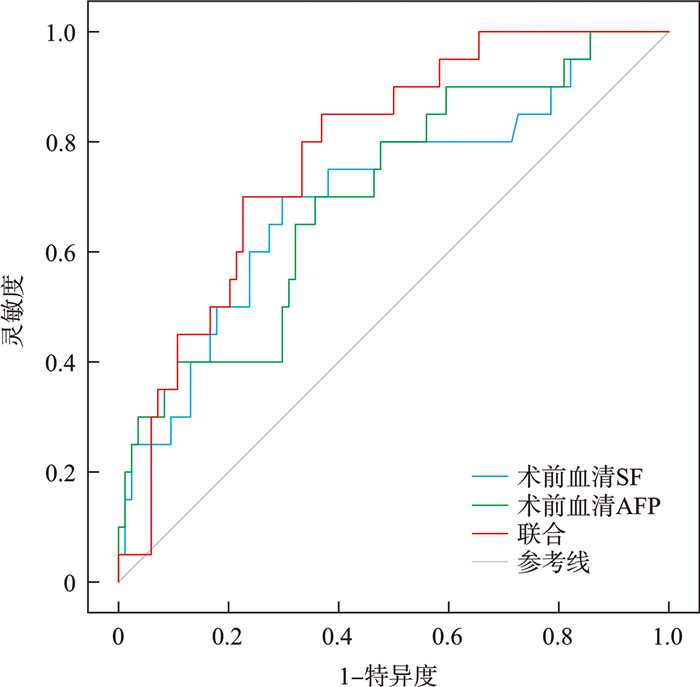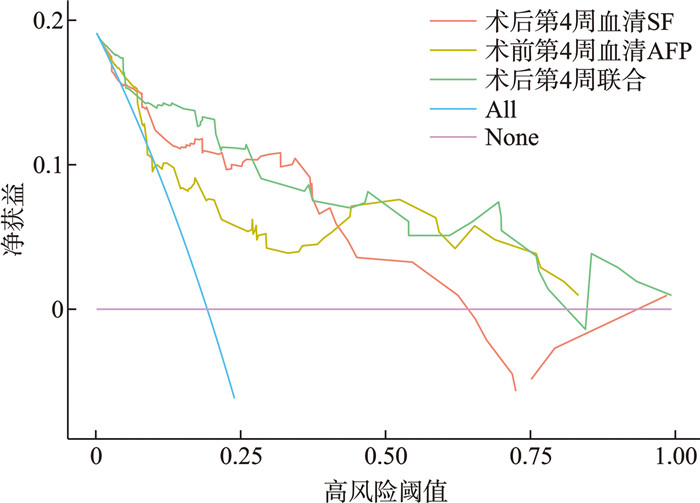Changes in serum ferritin and alpha fetoprotein levels in non-small cell lung cancer patients and their predictive analysis for postoperative recurrence
-
摘要: 目的 观察非小细胞肺癌(NSCLC)患者血清铁蛋白(SF)、甲胎蛋白(AFP)的变化情况,探讨血清SF、AFP对患者术后复发的预测价值。方法 前瞻性纳入2022年1月—2022年12月医院行胸腔镜肺癌根治术治疗的104例NSCLC患者为研究对象,患者术后均接受同方案化疗(TP化疗方案)。所有患者术前、术后4周时进行血清SF、AFP检查。对患者进行为期12个月随访,统计NSCLC患者术后复发情况并依据结局将患者分为复发组和未复发组。比较2组患者手术前后血清SF、AFP的变化情况,并分析血清SF、AFP对NSCLC术后复发的预测价值。结果 所有患者均顺利完成试验,无剔除病例。术后随访12个月期间,104例患者复发20例,复发率约19.23%。复发组术前血清SF、AFP水平均高于未复发组,差异有统计学意义(P<0.05);术后第4周时,2组血清SF、AFP水平均较术前降低,但复发组血清SF、AFP水平仍高于未复发组(P<0.05)。绘制受试者工作特征(ROC)曲线图,结果显示,术前、术后第4周时,血清SF、AFP单独及联合预测NSCLC患者术后复发的曲线下面积(AUC)均≥0.70,均有一定预测价值;而术后第4周时,血清SF、AFP联合预测NSCLC患者术后复发的价值优于术前联合预测(Z=2.021,P=0.022)。基于术后4周的血清SF、AFP水平绘制决策曲线,结果显示,当高风险阈值为0~0.80时,净收益率>0;在阈值0~0.25范围内,术后第4周时血清SF、AFP联合预测NSCLC患者术后复发的净获益率高于单一指标检测。结论 NSCLC患者术后血清SF、AFP水平降低,手术前后血清SF、AFP水平预测患者术后复发均有一定临床价值,且术后第4周时血清SF、AFP对患者术后复发的预测效能更理想。Abstract: Objective To observe the changes in serum ferritin(SF) and alpha fetoprotein(AFP) in non-small cell lung cancer(NSCLC) patients, and explore the predictive value of serum SF and AFP for postoperative recurrence in patients.Methods A prospective study was conducted on 104 NSCLC patients who underwent thoracoscopic radical surgery for lung cancer in a hospital from January 2022 to December 2022. All patients were examined for serum SF and AFP before and 4 weeks after operation. The patients were followed up for 12 months. The postoperative recurrence of NSCLC patients was counted and the patients were divided into recurrence group and non-recurrence group according to the outcome. The changes of serum SF and AFP before and after operation were compared between the two groups, and the predictive value of serum SF and AFP for postoperative recurrence of NSCLC was analyzed.Results All patients successfully completed the trial and no cases were excluded. During the 12 month follow-up period after surgery, 20 out of 104 patients experienced recurrence, with a recurrence rate of approximately 19.23%. The preoperative serum SF and AFP levels in the recurrence group were higher than those in the non recurrence group, with statistical significant differences(P < 0.05). At the 4th week after surgery, the serum SF and AFP levels in both groups decreased compared to before surgery, but the serum SF and AFP levels in the recurrence group were still higher than those in the non recurrence group(P < 0.05). The receiver operating characteristic(ROC) curve was drawn. The results showed that the area under the curve(AUC) of serum SF, AFP alone and combined in predicting postoperative recurrence of NSCLC patients was≥0.70 before and 4 weeks after operation, which had certain predictive value. At the fourth week after surgery, the combined prediction of serum SF and AFP for postoperative recurrence in NSCLC patients was more valuable than preoperative prediction(Z=2.021, P=0.022). Based on the serum SF and AFP levels at 4 weeks post surgery, a decision curve was drawn. The results showed that when the high-risk threshold was between 0 and 0.80, the net return rate was greater than 0. Within the threshold range of 0-0.25, the combined prediction of serum SF and AFP for postoperative recurrence in NSCLC patients at 4 weeks after surgery had a higher net benefit rate than single indicator detection.Conclusion The serum SF and AFP levels in NSCLC patients decrease after surgery, and both preoperative and postoperative serum SF and AFP levels have certain clinical value in predicting postoperative recurrence. Moreover, serum SF and AFP at the 4th week after surgery have a more ideal predictive effect on postoperative recurrence in patients.
-

-
表 1 复发组、未复发组基线资料比较
例(%),X±S 基线资料 复发组(n=20) 未复发组(n=84) 统计值 P 年龄/岁 χ2=0.274 0.601 ≥60 15(75.00) 58(69.05) <60 5(25.00) 26(30.95) 性别 χ2=0.025 0.875 男 12(60.00) 52(61.90) 女 8(40.00) 32(38.10) BMI/(kg/m2) 21.65±1.02 21.44±1.06 t=0.802 0.425 合并高血压 χ2=0.475 0.491 是 11(55.00) 39(46.43) 否 9(45.00) 45(53.57) 合并2型糖尿病 χ2=0.085 0.771 是 4(20.00) 12(14.29) 否 16(80.00) 72(85.71) 合并高脂血症 χ2=0.119 0.730 是 6(30.00) 22(26.19) 否 14(70.00) 62(73.81) 肿瘤直径/cm 4.82±0.65 4.78±0.63 t=0.254 0.800 病理类型 χ2=0.356 0.837 腺癌 8(40.00) 36(42.86) 鳞癌 5(25.00) 16(19.05) 其他 7(35.00) 32(38.10) 肿瘤TNM分期 χ2=21.401 <0.001 Ⅲ期 15(75.00) 18(21.43) Ⅰ/Ⅱ期 5(25.00) 66(78.57) 术前淋巴结转移 χ2=0.248 0.619 有 11(55.00) 41(48.81) 无 9(45.00) 43(51.19) 吸烟史 χ2=0.457 0.499 有 14(70.00) 52(61.90) 无 6(30.00) 32(38.10) CEA/(ng/L) 108.23±13.52 92.26±12.75 t=4.977 <0.001 SCC/(ng/mL) 10.23±2.35 7.35±1.86 t=5.904 <0.001 CYFRA21-1/(ng/mL) 9.48±1.28 6.08±1.32 t=10.411 <0.001 表 2 复发组、未复发组术前及术后第4周时血清SF、AFP水平比较
μg/L,X±S 组别 例数 血清SF 血清AFP 术前 术后第4周 术前 术后第4周 复发组 20 478.26±32.15 312.25±28.321) 292.42±22.61 122.35±15.481) 未复发组 84 458.84±30.36 284.54±26.421) 275.43±21.84 104.35±12.531) t - 3.067 4.157 3.105 4.566 P - 0.003 <0.001 0.005 <0.001 与同组术前比较,1)P<0.05。 表 3 术前血清SF、AFP单独及联合对NSCLC患者术后复发的预测价值
项目 AUC AUC 95%CI SE P 最佳阈值/(μg/L) 灵敏度 特异度 约登指数 SF 0.707 0.573~0.841 0.068 0.004 476.25 0.700 0.702 0.402 AFP 0.703 0.576~0.830 0.065 0.005 281.66 0.700 0.643 0.343 SF+AFP 0.780 0.681~0.880 0.051 <0.001 - 0.850 0.631 0.481 表 4 术后第4周时的血清SF、AFP单独及联合对NSCLC患者术后复发的预测价值
项目 AUC AUC 95%CI SE P 最佳阈值/(μg/L) 灵敏度 特异度 约登指数 术后第4周SF 0.857 0.761~0.953 0.049 <0.001 304.150 0.750 0.905 0.655 术后第4周AFP 0.779 0.662~0.896 0.060 <0.001 111.815 0.700 0.738 0.438 SF+AFP 0.905 0.836~0.973 0.035 <0.001 - 0.850 0.845 0.695 -
[1] 张振世, 师智勇, 刘圣武. 全腔镜解剖性肺段切除术对早期非小细胞肺癌患者肺功能及术后并发症的影响[J]. 实用癌症杂志, 2023, 38(9): 1529-1532. doi: 10.3969/j.issn.1001-5930.2023.09.035
[2] 薛丽英, 张朦, 王珏, 等. 趋化因子CCL5和基质金属蛋白酶9表达水平与非小细胞肺癌术后复发的相关性[J]. 医学临床研究, 2019, 36(8): 1522-1524. doi: 10.3969/j.issn.1671-7171.2019.08.024
[3] 马建新, 严丽花, 甘志忠, 等. 卵巢癌患者NSE、CYFRA21-1、Fer表达及与淋巴结转移的关系分析[J]. 临床血液学杂志, 2023, 36(2): 98-103. doi: 10.13201/j.issn.1004-2806.2023.02.005
[4] 彭凤翔, 高蓉梅, 李永春, 等. 非小细胞肺癌患者血清铁蛋白表达水平及其对微血管侵犯预测价值研究[J]. 现代检验医学杂志, 2023, 38(2): 171-175.
[5] 吕珊珊, 豆亚伟, 陈耀华, 等. 血清癌胚抗原、甲胎蛋白、人附睾上皮分泌蛋白4水平与非小细胞肺癌患者预后的关系[J]. 癌症进展, 2022, 20(16): 1663-1666.
[6] 严孝岭, 刘国瑞, 李晓军, 等. 血清七种自身抗体与传统肿瘤标志物在肺癌诊断中的价值分析[J]. 东南大学学报(医学版), 2022, 41(4): 505-510.
[7] 陈文俊. 非小细胞肺癌诊疗指南: 循证医学与治疗基础[M]. 西安: 陕西科学技术出版社, 2011: 214.
[8] 李彦明, 郝雁冰, 杨继雷, 等. 血清S-CD105 VEGF MMP9表达与非小细胞肺癌根治术后再复发的关系[J]. 河北医学, 2020, 26(8): 1281-1286.
[9] 陈从华, 明炜, 龚顺松, 等. CEA、NSE及CYFRA21-1对老年非小细胞肺癌患者手术预后判断的价值[J]. 河北医药, 2017, 39(5): 675-677, 682.
[10] Amin MB, Edge SB, Greene FL, et al. AJCC Cancer Staging Manual[M]. 8th ed. New York: Springer, 2016: 203-220.
[11] Ni Y, Peng JC, Yang X, et al. Multicentre study of microwave ablation for pulmonary oligorecurrence after radical resection of non-small-cell lung cancer[J]. Br J Cancer, 2021, 125(5): 672-678. http://www.nstl.gov.cn/paper_detail.html?id=ff54c157552cc9450da6dce4b21c22e6
[12] 王黎, 占根生, 何思东, 等. 非小细胞肺癌组织中磷酸化4E结合蛋白1表达及其与根治术后复发的关系[J]. 中国中西医结合外科杂志, 2023, 29(4): 469-473.
[13] Luo P, Qiao F, Dou PH, et al. Association between microRNA 25 expression in serum and lung cancer: a protocol for systematic review and meta-analysis[J]. Medicine(Baltimore), 2020, 99(20): e20263. http://doc.paperpass.com/foreign/rgArti2020307334125.html
[14] 王总飞, 刘先本, 张瑞祥, 等. 非小细胞肺癌患者血清铁蛋白、胸苷激酶1、基质金属蛋白酶9表达及临床价值探讨[J]. 实用医院临床杂志, 2019, 16(3): 103-105.
[15] 王玲, 申鸿. 癌胚抗原、糖类抗原、CA125、血管生成素、细胞角蛋白19片段及甲胎蛋白检测在肺癌诊断中的临床研究[J]. 陕西医学杂志, 2019, 48(8): 1080-1084.
[16] 谢锦华, 吉浩明, 陈国栋, 等. 小细胞肺癌患者血清铁蛋白、红细胞沉降率和红细胞平均指数水平与预后的关系[J]. 国际肿瘤学杂志, 2018, 45(8): 465-469.
[17] 邓青, 程蔚蔚, 陈岚. 高密度脂蛋白胆固醇、铁蛋白、整合素α3与Ⅳ期非小细胞肺癌病理特征及患者生存预后的相关性[J]. 实用癌症杂志, 2022, 37(10): 1591-1595.
[18] 杨青茹, 张淼. 非小细胞肺癌术后免疫功能与铁蛋白、癌胚抗原的相关性[J]. 临床和实验医学杂志, 2018, 17(11): 1215-1218.
[19] 徐李红, 王禺, 岳虹. 血清五项肿瘤标志物及降钙素原水平在肺腺癌化疗前后的变化及其临床意义[J]. 医学临床研究, 2022, 39(9): 1395-1398.
[20] 李媚, 刘敏思, 黄月华, 等. 甲胎蛋白联合载脂蛋白A1、碱性磷酸酶等指标在HBV相关肝癌诊断中的价值[J]. 新医学, 2023, 54(9): 671-675.
[21] 刘利, 邓太兵, 唐藜. 血清CA125、AFP表达与NSCLC患者化疗效果的相关性[J]. 中国实验诊断学, 2023, 27(6): 655-658.
[22] Urban SK, Sänger H, Krawczyk M, et al. Synergistic effects of extracellular vesicle phenotyping and AFP in hepatobiliary cancer differentiation[J]. Liver Int, 2020, 40(12): 3103-3116. http://pubmed.ncbi.nlm.nih.gov/32614460/
-

计量
- 文章访问数: 55
- 施引文献: 0




 下载:
下载:

